April 12, 2017
by Carole Zangari -
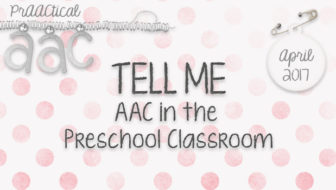
Do you work in or support preschool classrooms? Are you interested in infusing more AAC teaching throughout the day? If so, the TELL ME program may be of interest. This post has an overview of the program I developed with my friend and colleague, Lori Wise, in order to give teachers and therapists a better understanding of ways that they can integrate AAC learning throughout the classroom day. Many thanks to the fine folks at Saltillo for inviting me to do this webinar and for allowing us to share the recording. We are grateful for the support of SLP Joni Nygard and the wonderful team at Attainment for helping us bring this work to fruition. You can download the handout for the video here and see some samples of the TELL ME program here. What works for you in teaching AAC in the preschool classroom? Share your ideas so we can... [Read More...]
Filed under: Video of the Week
April 5, 2017
by Carole Zangari -
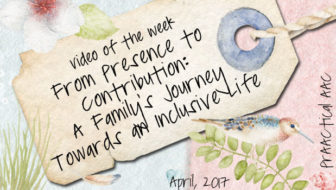
Why do we work so hard to support effective communication through AAC? In the end, the real goal is to help people live rich and enviable lives. Working toward that starts with a vision and that’s the subject of Erin Sheldon’s talk, Including Maggie. Many thanks to Kathy Howery and the Alberta Regional Professional Development Consortia for making this available. If you think you know inclusion and if you think you know what the end game is in AAC, don’t skip this. All of us have something to learn from this family’s journey toward an inclusive life. Direct Link to Video – https://www.youtube.com/watch?v=Rkf3LD6047s&list=PL6P1FySUgEPR1aG-ZRYi363jtaniNJFqC&index=13
Filed under: Video of the Week
Tagged With: inclusion, Inclusive Education, planning
March 29, 2017
by Carole Zangari -

Ensuring that AAC systems include high frequency words sets the stage for us to teach language that is flexible and functional across a variety of settings. For whom is that appropriate? How many words? Which ones? In today’s featured video, master clinician Gail Van Tatenhove tackles all of these issues and more. This video and the accompanying resources (which can be found here) were part of the Power AAC series Gail created for PaATTAN to support their efforts in building capacity for high quality AAC services. We’re indebted to them for making this available so all can learn from it.
Filed under: Video of the Week
Tagged With: core vocabulary, PaTTAN, vocabulary selection
March 22, 2017
by Carole Zangari -

Looking for a core+fringe AAC display that is easy to make and not overwhelming to use? This post may have just what you need. It’s great to see the variety of ways in which professionals are embracing AAC options and using what they know to teach others. In today’s post, we feature a video by the Louisiana South/Central Regional AT Center in which they take us through the step-by-step process of making a versatile AAC support that can be a wonderful starting point for some of our learners. In addition to the video, this generous team shares their files so you can make one of your own (click here to download; you can get the SymbolStix version here) and even share the source for the vinyl pockets they use. Pretty prAACtical! Thanks, Louisiana South/Central Regional AT Center, for your collegiality in sharing this with all of us!
Filed under: Video of the Week
Tagged With: communication book, core, DIY
March 15, 2017
by Carole Zangari -
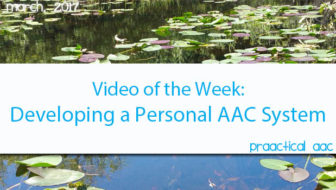
We’re back to learn more from Gail Van Tatenhove with more in the Power AAC series from PaTTAN. In this video, Gail reviews key concepts in developing a multi-component AAC system that meets the needs of an individual learner. This is a great resource for helping teams make the important decisions that lead to a set of individualized AAC tools or evaluate their students’ current AAC systems to see where adjustments might be needed. We’re grateful to Gail and to PaTTAN for this wonderful series. Be sure to download the handouts in the Links and Downloads section. Direct Link to Video – https://www.pattan.net/videos/poweraac-module-3-develop-personal-aac-systems
Filed under: Video of the Week
March 8, 2017
by Carole Zangari -
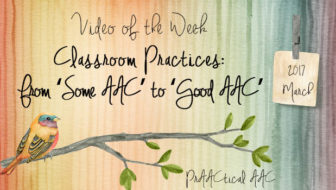
The good news is plentiful. A growing number of classrooms incorporate some form of AAC. Teachers and therapists are increasingly aware of the value of augmentative forms of communication and are recognizing the potential for communication growth in all of their students. School teams are stepping up to provide access to activity-based communication boards, communication books, low tech SGDs, and AAC apps. They are creating opportunities for teaching and using these forms of AAC in specific classroom activities. In many cases, teachers and therapists are growing dissatisfied with the outcomes. Students are more engaged in the activities are improving their ability to participate appropriately. They aren’t always becoming competent communicators who can express themselves independently throughout the day. It’s frustrating to scramble to find and/or create materials and resources, make significant changes to activities, work hard to implement them, and still not get the expected outcome. It’s exhausting. It’s disappointing,... [Read More...]
Filed under: Video of the Week
March 1, 2017
by Carole Zangari -
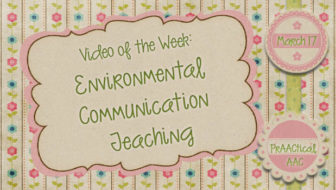
Back in the late 1980’s when I was doing my doctoral work at Purdue University, there was exciting research going on in classroom-based AAC intervention. Environmental Communication Teaching (ECT) has been through some changes in the past 25+ years, but it is still a powerful approach to helping teams support learners with complex communication needs. In today’s video, we feature Kelly Fonner discussing ECT as part of a webinar made possible by the Alberta Regional Professional Development Consortia. You can download the accompanying handout here. Enjoy! Many thanks to the Alberta Regional Professional Development Consortia for making this available.
Filed under: Video of the Week
Tagged With: classroom, ECT, Kelly Fonner
February 22, 2017
by Carole Zangari -

Speed dating, AAC style? Some days, we just need a little bit of fun. Happy Wednesday, prAACtical friends! Direct link to video: https://vimeo.com/46831064
Filed under: Video of the Week
Tagged With: fun, video
February 15, 2017
by Carole Zangari -

Yesterday was Valentine’s Day. Sally SLP planned an adorable craft activity, but her students with autism and AAC needs just didn’t take to it. Tara Teacher brought out some age-respectful stickers to decorate cards, but several of the students stopped after placing just one sticker and got frustrated when encouraged to add more. Olivia OT pushed into the classroom as they were painting hearts to help with fine motor skill development, but some of the kids resisted doing anything more than a few brush strokes. Sound familiar? Art activities offer great potential for communication learning and practice, but they aren’t always preferred activities for some of our AAC students. There can be several good reasons for that, but a common problem is that the activity itself may be too open-ended. Some of our students do best with activities that have a clear beginning and ending. Open-ended activities, like many of... [Read More...]
Filed under: Video of the Week
Tagged With: object schedule, participation, visual supports
February 8, 2017
by Carole Zangari -
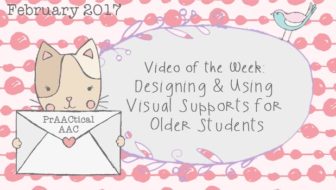
Chances are, you are already using visual supports with your AAC learners. If they aren’t as effective as you imagined they would be, or if you need ideas for how to make them more appropriate for middle and high school students, this video is worth watching. Karine Gleason helps us learn more about making age respectful visual boundaries, cues, and schedules, and gives us tips for fine-tuning our implementation. Many thanks to TASN and the Tri-State Autism Spectrum Disorder Network for making and sharing this video.
Filed under: Video of the Week
Tagged With: older learners, visual supports









